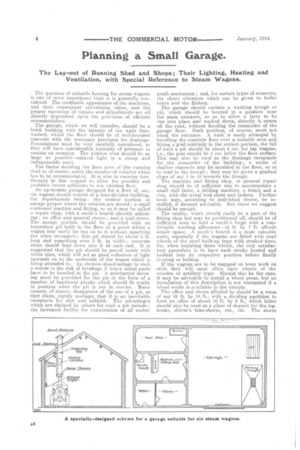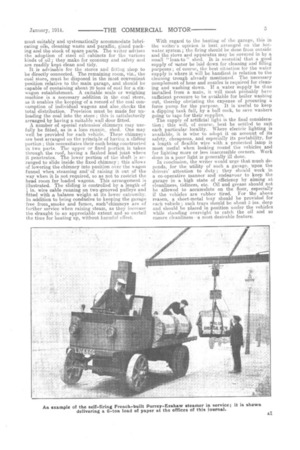Planning a Small Garage.
Page 4

Page 5

If you've noticed an error in this article please click here to report it so we can fix it.
The Lay-out of Running Shed and Shops ; Their Lighting, Heating and Ventilation, with Special Reference to Steam Wagons.
The question of suitable housing for steam wagons is one of more importance than it is generally considered. The creditable appearance of the machines, and their consequent advertising value, and the proper execution of repairs and adjustments are all directly dependent upon the provision of efficient accommodation.
The garage, which we will consider, should be a brick building with the interior of the walls limewashed, whilst the floor should be of well-founded concrete with the necessary provision for drainage. Foundations must be very carefully considered, as they will have considerable intensity of pressure to sustain on occasion. The window area should be as large as possible—natural light is a cheap and indispensable asset.
The factor deciding the floor area of the running shed is, of course, solely the number of vehicles which has to be accommodatA. It is wise to exercise forethought in this respect to allow for possible and probable future additions to any existing fleet. An up-to-date garage designed for a fleet of, say, six wagons should consist of a four-division building, the departments being: the central portion . or garage proper where the vehicles are stored ; a small combined machine and fitting, or as it may be called a repair shop, with a smith's hearth directly adjoining; an office and general stores ; and a coal-stores. The garage portion should be provided with an inspection pit built in the floor at a point where a wagon may easily be run on to it without upsetting the other occupants; this pit should he about 8 ft. long and something over 3 ft. in width ; concrete steps should lead down into it at each end. It is suggested that the pit should be paved inside with white tiles, which will act as good reflectors of light waRds on to the underside of the wagon which is being attended to. An obvious disadvantage to such
course is the risk of breakage if heavy metal parts have to be handled in the pit. A substantial covering must be provided for the pit in the form of a number of haKiWood planks which should fit neatly in position when the pit is not in service. Many owners, of course, disapprove of the use of a pit, as they claim, rightly perhaps, that it is an inevitable receptacle for dirt and rubbish. The advantages which are claimed by others for such a pit include : the increased facility for examination of all under
neath mechanism ; and, for certaiii types of steamers, the closer attention which can be given to boiler tubes and the firebox.
The garage should contain a washing trough or pit, which should be located in a position near the main entrance, so as to allow a lorry to be run into place arid washed down, directly it comes off the road, without flooding the remainder of the garage floor. Such position, of course, must not block the entrance. A wash is easily arranged by bevelling the concrete floor over a suitable area and fitting a grid centrally in the sunken portion, the fall of such a pit should be about 5 ins, for big wagons, i.e., the grid should be 5 ins, below the floor surface. This may also be used as the drainage receptacle for the remainder of the lruilding; a series of shallow channels may he moulded in the floor, so as to lead to the trough; they may be given a gradual slope of say 1 in 40 towards the trough. The machine and fitting shop, or general repair shop should be of sufficient size to accommodate a small stiff lathe, a drilling machine, a bench and a vice, with the usual tool chest and lockers. Further tools may, according to individual choice, be installed, if deemed advisable. But those we suggest should he enough.
The smithy, which should really be a part of the fitting shop b:rat may be partitioned off, should be of sufficient area to bold a smith's forge with a comfortable working allowance—P2 ft. by 7 ft. affords ample space. A smith's hearth is a most valuable asset, especially if the wagons are fitted with road wheels of the steel built-up type with .straked tires, for, when replating these wheels, the only satisfactory psocodure is to have each strake heated and bedded into its respective position before finally riveting or bolting.
If the wagons are to be engaged on town work on setts they will most often have wheels of the wooden or artillery type. Should this be the case, it may be advisable to install a wheel press, but an installation of this description is not warranted if a wheel works is available ID the vicinity.
The office and stores alluded to should be a MGM of say 22 ft. by 10 ft., with a dividing partition to form an office of about 10 ft. by 9 ft., which latter should also be used as a plane of deposit for the logbooks, driver's, time-sheets, etc., etc. The stores
must suitably and systematically accommodate lubricating oils, cleaning waste and paraffin, gland packing and the stock of spare parts. The writer advises the adoption of steel oil cabinets for the various kinds of oil ; they make for economy and safety awl are readily kept clean and tidy. It is advis.a.ble for the stores and fitting shop to be directly connected. The remaining room, viz., the coal store, must be disposed in the most convenient position relative to the main, garage, and should be capable of containing about 20 tons of coal for a sixwagon establishment. A suitable scale or weighing machine is a necessary addition in the coal store, as it enables the keeping of a record of the coal consumption of individual wagons and also.checks the total distribution. Provision must be made for unloading the coal into the store ; this is satisfactorily arranged by having a suitable wall door fitted.
A number of special extensionchimneys may usefully be fitted, as in a. loco runnine shed. One may well be provided for each vehicle. These chimneys are best arranged on the principle of having a sliding portion ; this necessitates their each being constructed in two parts. The upper or fixed portion is taken through the roof, having a flashed lead joint where it penetrates. The lower portion of the shaft is arranged to slide inside the fixed chimney ; this allows of lowering the chimney into position over the wagon funnel when steaming and' of raising it out of the way when it is not required, so as not to restrict the head room for loaded wagons. This arrangement is illustrated. The sliding is controlled by a length of in. wire cable running on two .grooved pulleys and fitted with a balance weight at its lower extremity. In addition to being conducive to keeping the garage free fromotnoke and fumes, such'chinaneys are of further service when raising steam, as they increase the draught to an appreciable extent and so curtail the time for heating up, without harmful effeet.
With regard to the heating of the garage, this in the writer's opinion is best arranged on the hotwater system.; the firing should be done from outside and the stove and apparatus may be covered in by a small " lean-to" shed. It is essential that a good supply of water be laid down for cleaning and filling purposes ; of course, the best situation for the water supply is where it will be handiest in relation to the cleaning trough already mentioned. The necessary complement of hose and nozzles is required for cleaning and washing down. If a water supply be thus installed from a main, it will most probably have sufficient pressure to be available for boiler washing out, thereby obviating the expense of procuring a force pump for the purpose. It is useful to keep a dipping tank full, by a ball cock, to save washers going to taps for their supplies. The supply of artificial light is the final considers,tion ; this will, of course, best be settled to suit each particular. locality. 11There electric lighting is available, it is wise to adopt it On account of its safety, cheapness, and especially its portability, for a length of flexible wire with_a protected lamp is most useful when looking round the vehicles and for lighting more or less inaccessible corners. Work done in a poor light is generally ill done.
In conclusion, the writer would urge that much depends, for the utility of such a garage, upon the drivers' attention to duty ; they should work in a co-operative manner and endeavour to keep the garage in a high state of efficiency by aiming at cleanliness, tidiness, etc. Oil and grease should not be allowed to accumulate on the floor, especially if the vehicles are rubber tired. For the above reason, a sheet-metal tray should be provided for each vehicle ; such trays should be about 3 ins deep and should be placed in position under the vehicles while standing overnight to catch the oil and so ensure cleanliness—a most desirable feature.






















































































